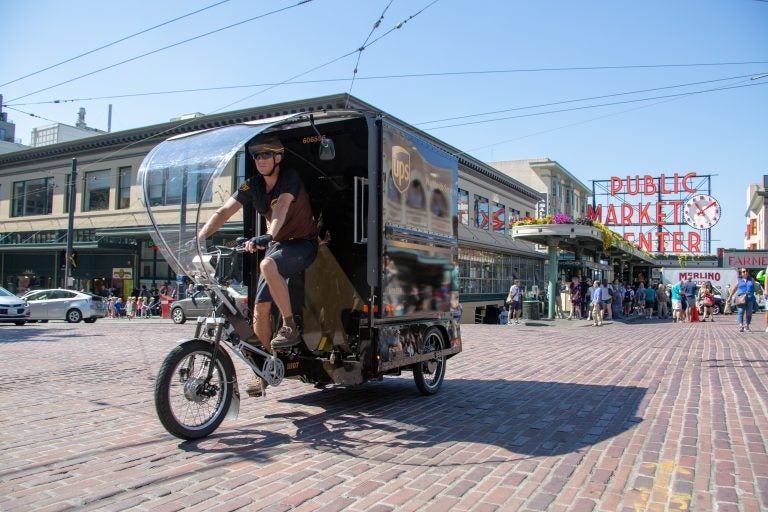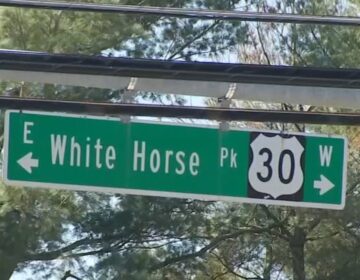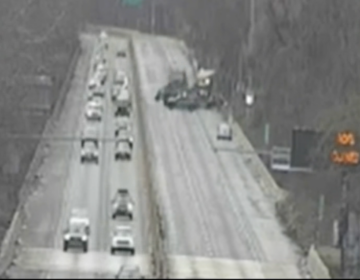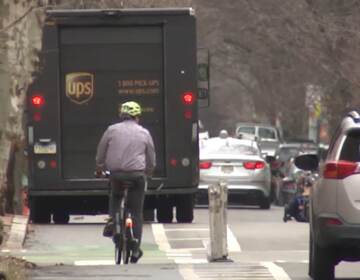UPS is trading trucks for tricycles in some cities. Cargo trikes could also roll in Philly one day
UPS is introducing cargo e-bikes in some U.S. cities. Philadelphia officials say the City of Brotherly Love could benefit from the trikes.

UPS is introducing cargo e-bikes in some U.S. cities. Philadelphia officials say the City of Brotherly Love could benefit from the trikes. (Courtesy of UPS)
This story originally appeared on PlanPhilly.
—
When UPS announced it would start using a battery-powered cargo tricycle to make some of its downtown deliveries, the mayor greeted the plan with open arms.
The delivery giant had already deployed similar e-bikes in Oregon, Florida, and several European cities, and now urbanites in Pennsylvania would get to see a cyclist clad in a familiar brown uniform bringing parcels to shops and offices without jamming narrow city streets and pumping exhaust into the air.
“We welcome solutions like the UPS eBike to reduce traffic congestion and tackle urban growth,” the mayor said. “We encourage companies like UPS to work with our residents and businesses to create innovative solutions to the complex urban challenges we face every day.”
Sadly, though, for Philadelphia residents who have lost many hours stuck in Center City traffic made worse by double-parked UPS trucks, the enthusiastic comments came not from Mayor Jim Kenney, but from Pittsburgh Mayor Bill Peduto.
UPS launched the pedal-assist cargo trike in the Steel City in November 2017, passing up Philly in favor of an urban center known for its leadership on self-driving car research and other transportation innovations.
The company went on to deploy a similar vehicle in Seattle last year, and plans to start using an e-bike in another U.S. city in the first half of 2019. It apparently won’t be Philadelphia; UPS works with host cities to iron out the details of a deployment in advance, and officials at Philadelphia’s Office of Transportation and Information Systems (OTIS) said they had not heard about any e-bike plans from the company. UPS declined to identify the new city.
Yet OTIS officials say that from a regulatory perspective, it would be quite easy for UPS to use a cargo e-bike here. State law allows e-bikes without any special permit, as long as they are activated by pedaling, not fully battery-powered, and don’t go faster than 20 miles per hour. Food delivery people can often been seen whizzing around on battery-powered bikes, and the Indego bike share program recently added 10 e-bikes to its fleet.
An e-bike could also complement Philadelphia’s heightened focus on downtown congestion. Last fall, the city launched an enforcement blitz against illegally parked vehicles on Market and Chestnut streets, and it will release a policy document on curbside vehicle management in the next few months. Officials are considering changes to the signposted loading and parking hours on Chestnut and investigating how to create paid, permitted loading spots in some areas, OTIS deputy managing director Mike Carroll said.
As those efforts move ahead, Carroll said he will be interested in hearing from delivery companies about the benefits that e-bikes and other alternative delivery methods have produced in other cities.
“There’s a defined role e-bikes can play, and on certain corridors it will be interesting to see how they may help offset some of the truck traffic, some of the operational issues like double-parking and so forth, where it’s just going to be easier to negotiate a narrower right-of-way in a vehicle like that,” Carroll said. “We’re very much open to the proposals that [companies] might make, and as we get into the new year, I expect to be interacting with them a little bit more to hear what they’re thinking about and to see what we can do.”
The city action comes in response to worsening congestion that has measurably slowed travel times across Center City. On Chestnut, Sansom and Walnut streets, travel times for car trips from Broad to 23rd Street increased 10 to 20 percent between 2013 and 2017, according to a Center City District study. Bus trips took an even bigger hit, taking 25 to 40 percent longer.
“We see it a lot, where a delivery truck has nowhere else to go, they stop to make a delivery, along comes one of the big articulated SEPTA buses, they can’t get around, and now you’ve got both lanes kind of stuck,” said Mike Ruane, a planner who studies delivery issues at the Delaware Valley Regional Planning Commission. “It is a challenge.”
The surge in truck traffic is driven by Center City’s economic growth and the continuing expansion of e-commerce. Nationally, UPS is delivering 19 percent more packages than it did in 2010 and FedEx 44 percent more. Center City businesses and residents receive an estimated 18,000 deliveries a day. In addition, at least 20,000 Uber and Lyft drivers are constantly circulating around the city, stopping at curbs to pick up and drop off passengers. Other factors include positive developments like more people walking and bicycling, which make Philadelphia’s narrow streets even more crowded.
“All of these new strains on that limited right-of-way, that limited resource, are creating new challenges for accommodating the level of activity we’re seeing,” Ruane said. “One of the potential solutions, then, is how do we remove some of the truck trips, or how do we reduce the amount of real estate dedicated to those deliveries? The cargo bike can be a piece of that solution.”
UPS first tested e-bikes in Hamburg, Germany in 2012. The company says it now does inner-city delivery by foot and bike in more than 30 cities, including Dublin, London, Paris and Rome, and may start using bikes in some Asian cities. Its first U.S. pilot began in Portland, Oregon in 2016 and lasted a year. That was followed in 2017 by e-bikes in Pittsburgh and Fort Lauderdale, which remain in use.
Last year the company launched e-bike delivery in Seattle with a new “plug and play” design. A truck drops off four cargo modules loaded with packages in a private parking area and the e-bike driver attaches one of the modules to the back of the bike. The driver cycles around downtown Seattle, dropping off packages, then switches out modules and makes another delivery run.
“He literally just takes the back of the vehicle off and puts the other back of the vehicle on,” said Tom Madrecki, UPS’s director of urban innovation and mobility. “It really cuts down on his time handling the packages and speeds up the efficiency of the operation, which gets it a little bit closer to being as efficient as a standard truck model, while retaining the bike aspects of it.”
The front of the vehicle resembles a typical e-bike, with a box-like battery unit attached to the frame. But on UPS’ customized trike, the helmeted delivery driver is partially protected by a curving windshield and roof, which is attached on top to the rear cargo hold, a brown cube sitting on a two-wheeled trailer base.
A video provided by UPS shows the vehicle moving slowly through car traffic, its rear lights flashing. The driver at one point rides onto a sidewalk and parks in front of a store (which would likely not be legal in Philadelphia), and is later shown riding on a protected bike lane and a wood boardwalk.
With its electric motor, the e-bike can travel longer distances than traditional bicycles, carry heavy loads, and easily go up hills, according to UPS. The 95-cubic-foot cargo box can hold up to 400 pounds of packages.
The Seattle system’s modular aspect is a “game-changer” for sustainable, last-mile goods movement, Madrecki said. That feature will appear in future UPS e-bike launches, with modifications for the needs and layout of each city.
E-bikes don’t necessarily work everywhere. In a vertically-oriented business district like Manhattan, it makes more sense to park a truck in a garage and have the driver spend the day shuttling loads up and down via elevator, Madrecki said. In London, meanwhile, UPS has a government-funded e-bike pilot in which a small cargo trailer converts into a electrically assisted hand cart that the driver pushes through doorways and moves within buildings, he said.
Madrecki said he could not comment on whether Philadelphia might get a UPS e-bike, but he noted that he was here for a DVRPC conference last year and has spoken about freight delivery issues generally with local planners. “The goal from our point of view is to foster those relationships with cities to lay the groundwork for future partnerships, to see what the needs are in each individual city, and where we can maybe fit in. We’re always eager to look at different cities and what we might be able to do in them,” he said.
Carroll cautioned that, as intriguing as e-bikes are, they’re just one small potential tool to address “a big ball of challenges that we’ve got to unravel” with regards to curbside management. They’re hardly a cure-all for congestion, he said.
“We’ll talk to folks and find out what benefits we get from shifting some of the delivery, perhaps, to e-bikes, but we’re not focused just on e-bikes for delivery. That’s not an initiative we’re undertaking in isolation of other things,” he said.
Madrecki said reducing overall use of cars is ultimately far more important than changing delivery methods.
“This sounds probably selfish for UPS to say, but if you look at congestion, it’s really not deliveries that are causing it,” Madrecki said. “People are like, ‘oh, there’s so much traffic.’ It’s important to remember, you’re never in traffic, you are traffic. The greatest emphasis, and where a city should be going full-steam ahead, is getting people out of personal vehicles and into shared mobility systems or walking or biking.”
WHYY is your source for fact-based, in-depth journalism and information. As a nonprofit organization, we rely on financial support from readers like you. Please give today.







